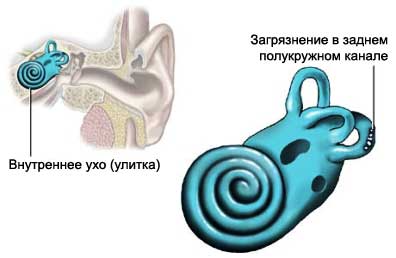Benign paroxysmal positional vertigo – DPPG
Description DPPG
Dizziness – the apparent sense of rotation, disorientation in space. Benign paroxysmal positional vertigo (DPPG) It is, when changing head position. It may appear after nagibaniya, turning the head in bed, or raise the head, to look up. People with DPPG can often determine, what movements cause the greatest problems.
If you suspect, that you have this disorder, consult a doctor.
Reasons DPPG
The inner ear contains tiny crystals, that can sense movement and help you keep your balance. DPPG arises due to a change in location of these crystals. When the crystals move or gather in one place, this can lead to DPPG.

The emergence of DPPG can cause:
- Traumatic brain injury;
- Viral infections, such as labyrinthitis (inflammation of a nerve in the ear);
- Diseases of the inner ear;
- Prolonged immobility of the head;
- Age-related changes in the inner ear.
Risk Factors DPPG
The following factors increase the risk of developing the disorder. If you have any of the risk factors, tell your doctor:
- Traumatic brain injury;
- Prolonged immobility of the head.
Symptoms of DPPG
These symptoms, except for BENIGN PAROXYSMAL POSITIONAL VERTIGO can be caused by other diseases. If you experience any of the symptoms, consult a doctor:
- Sudden dizziness, which lasts less than a minute;
- Sense of rotation;
- Dizziness after certain movements;
- Disequilibrium;
- Nausea;
- Vomiting;
- Feeling of instability;
- Fatigue;
- Wiggle.
Diagnosis of DPPG
The doctor will ask about your symptoms and medical history, and perform a physical examination. He will look for symptoms of dizziness when the head movements. It can be diagnosed pathological eye movement, which occurs as a result of vertigo. You may be directed to the doctor, who specializes in treating diseases of the ears (otolaringolog) or to a neurologist.
Tests may include the following:
- Electronystagmography – test, which uses electrodes to fix the eye movements; It is used to search for diseases of the inner ear;
- MRT – examination, which uses magnetic waves, to obtain images of internal body structures; It used to search for other problems in the brain, which may cause symptoms DPPG.
Treatment DPPG
Most cases go away DPPG, usually, within a few months after the onset of the disease. Treatment options for BENIGN PAROXYSMAL POSITIONAL VERTIGO include::
Vestibular exercises (Vestibular rehabilitation)
Your doctor may suggest some exercises (exercise Epley). These exercises use eye movement, head and body, to avoid dizziness.
Repositioning otoliths
Otoliths (stalotity) – crystals of calcium, perceiving various mechanical irritation, part of the system maintain a balance of human. The procedure is performed in a doctor's office. The doctor will move your head in different positions, to try to move the crystals. This procedure is sometimes repeated, and after the training can be performed in the home.
Operation at DPPG
Some patients may require surgery DPPG. During the operation can be used wax, for plugging one of the regions of the ear, that will prevent the movement of fluid in it.
Another type of surgery uses a cut-off of the nerve from the inner ear.
Prevention DPPG
At the moment, there are no methods, allowing to prevent the occurrence of DPPG.
